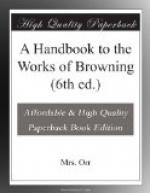Cristina’s last words are addressed, in vindication of her deed, to the priest (Lebel), who is aghast at its ferocity. He, she says, has received the culprit’s confession, and would not divulge it for a crown. The church at Avon[113] must tell how her secrets have been guarded by him to whom she had entrusted them.
“MARY WOLLSTONECRAFT AND FUSELI” is the mournful yet impassioned expression of an unrequited love.
“ADAM, LILITH, AND EVE” illustrates the manner in which the typical man and woman will proceed towards each other: the latter committing herself by imprudent disclosures when under the influence of fear, and turning them into a joke as soon as the fear is past; the former pretending that he never regarded them as serious.
“IXION” is an imaginary protest of this victim of the anger of Zeus, wrung from him by his torments, as he whirls on the fiery wheel.[114] He has been sentenced to this punishment for presuming on the privileges which Zeus had conferred upon him, and striving to win Here’s[115] love; and he declares that the punishment is undeserved: “he was encouraged to claim the love of Here, together with the friendship of Zeus; he has erred only in his trust in their professions. And granting that it were otherwise—that he had sinned in arrogance—that, befriended by the gods, he had wrongly fancied himself their equal: one touch from them of pitying power would have sufficed to dispel the delusion, born of the false testimony of the flesh!” He asks, with indignant scorn, what need there is of accumulated torment, to prove to one who has recovered his sight, that he was once blind; and in this scorn and indignation he denounces the gods, whose futile vindictiveness would shame the




